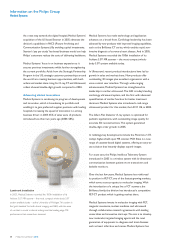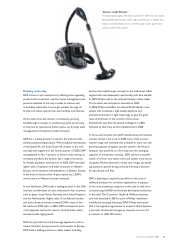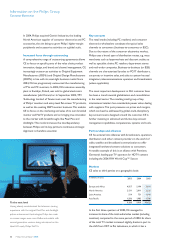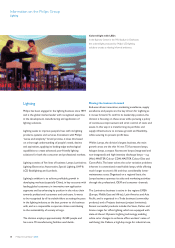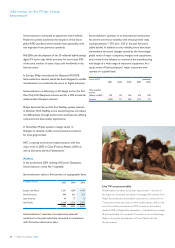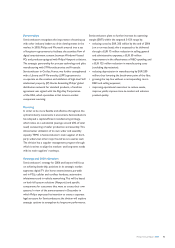Philips 2005 Annual Report Download - page 40
Download and view the complete annual report
Please find page 40 of the 2005 Philips annual report below. You can navigate through the pages in the report by either clicking on the pages listed below, or by using the keyword search tool below to find specific information within the annual report.
Philips Annual Report 200540
Information on the Philips Group
Lighting
Developing the solid-state lighting market
Lighting has been adopting a focused approach to developing
the solid-state lighting market. Main applications include
decorative lighting of buildings and shop lighting, where
thecoloredlighting,dynamics,exibilityandsmallsizeare
importantbenets.Followingtheprogressmadein2004,
further resources were allocated in 2005 to innovation,
manufacturing and marketing. This resulted in the successful
launch of a number of solid-state lighting products.
In November 2005, Philips completed the acquisition of
Agilent Technologies’ shares in the Lumileds venture, an
important step in Philips Lighting’s strategy to play a leading
role in the emerging solid-state lighting market.
Since its establishment in 1999, Lumileds has built up a
leading position in the LED (light-emitting diode) market.
ItspatentedLuxeonLEDsarethersttocombinethe
brightness of conventional lighting with the small footprint,
long life and other advantages of LEDs, and have become a
market reference for other players.
The combined strengths of Lumileds, as a leading-edge
supplier of inorganic LEDs, and Philips Lighting, as a supplier
of solid-state lighting modules and systems, will shorten
the time-to-market of advanced LED-based solutions.
Lumileds has its headquarters (and wafer fab operations)
in San Jose, USA, and its assembly operations in Penang,
Malaysia. The European sales management and supportive
engineering and development activities are located in
Best, Netherlands.
Pursuing technology leadership
In 2005, two major investments were announced in
West European plants to strengthen Lighting’s technology
leadership in applications with high growth potential.
In May, Philips announced a EUR 40 million investment in
the facility at Roosendaal, Netherlands, for LCD backlighting
technology used to improve the picture quality of LCD
widescreen televisions.
This was followed in September by the announcement of
a EUR 35 million investment to expand the production of
MASTER Colour CDM lamps in Turnhout, Belgium. These
lamps are used in indoor applications, especially shops,
where they allow shop owners to show off their products
under bright, true-to-life colors, and outdoors, where their
cozy, warm white light and natural colors enhance people’s
feeling of safety and comfort at night.
Energy saving
In Europe, Philips is running an awareness-raising campaign
tohighlighttheuntappedenvironmentalandnancial
potential of new energy-saving lighting systems. The initiative
provides information to municipalities and companies on
how they can save millions of euros on energy costs and
substantially reduce CO² emissions through lighting. The
‘green’ facts state that by switching to the latest road
lighting technology, Europe could reduce CO² emissions
by 3.5 million tons per year. This equates to the CO²
consumption of 175 million trees.
One of these new energy-saving systems, Philips’ CosmoPolis
for street lighting – besides providing a far higher quality
of ‘white’ light – uses less than half the energy of the
mercury-vapor lamps that still light about a third of Europe’s
roads and motorways, as well as offering industry-leading
low levels of mercury.
Like daylight itself
Shop lighting is becoming more colorful, more natural,
moreexibleandmoredynamic–likedaylightitself.
Philips’ MASTER Colour Elite lamp not only displays
merchandise in their natural, true colors, but also
allowsdimming–therstlampofitskindtodo
so for retail applications


